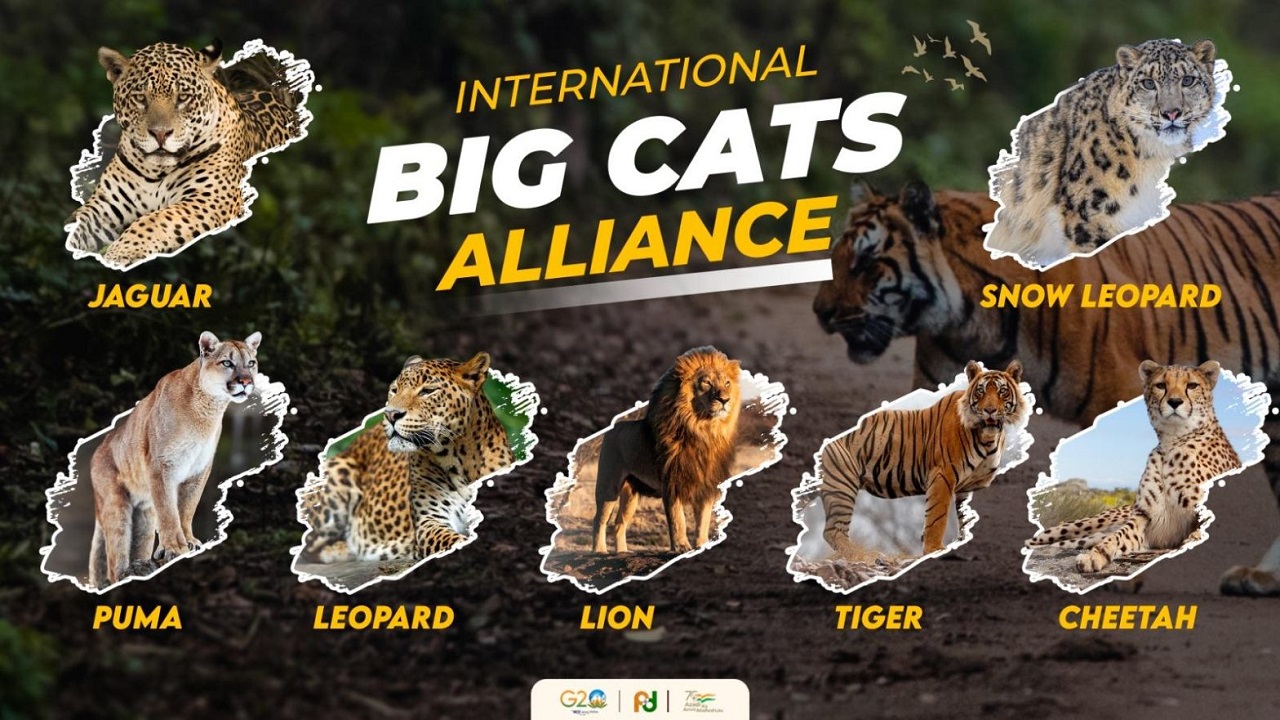International Big Cat Alliance: India’s Global Leadership in Wildlife Conservation
Context:
India has officially been designated as the Headquarters and Secretariat of the International Big Cat Alliance (IBCA), following a recent agreement signed between the Central Government and IBCA. This development strengthens India’s leadership in global wildlife conservation efforts.
About International Big Cat Alliance (IBCA)
-
IBCA is an international coalition of 96 countries — including both big cat range countries and non-range countries — committed to the conservation of seven big cat species and their habitats.
-
The concept of IBCA was first proposed by India's Prime Minister in 2019 and was officially launched on April 9, 2023, marking the 50th anniversary of Project Tiger.
Objectives of IBCA
-
To combat illegal wildlife trade involving the seven big cats.
-
To strengthen the protection and conservation of big cat habitats.
-
To mobilize financial and technical resources for conservation activities.
-
To build international cooperation on conservation practices, research, and policy exchange.
Focus Species
IBCA concentrates on the conservation of the following seven species:
Tiger, Lion, Leopard, Snow Leopard, Puma, Jaguar, and Cheetah.
Among these, five species are found in India:
Tiger, Lion, Leopard, Snow Leopard, and Cheetah.
Institutional Framework
-
Depository Authority: Ministry of External Affairs (MEA), Government of India.
-
Membership: Open to all United Nations member states. Initial members include:
-
Republic of India
-
Republic of Nicaragua
-
Kingdom of Eswatini
-
Federal Republic of Somalia
-
Republic of Liberia
-
-
Partner Organizations: Nine global organizations are associated as IBCA partners.
Governance Structure
-
The alliance functions through:
-
An Assembly of Members
-
A Standing Committee
-
A Secretariat (hosted by India)
-
-
The structure is modeled on the International Solar Alliance (ISA) framework.
-
The Director-General (DG) is appointed by the Ministry of Environment, Forest and Climate Change (MoEFCC).
Need for IBCA
-
Big cat populations face sharp decline due to:
-
Habitat loss
-
Poaching and illegal wildlife trade
-
Human-wildlife conflict
-
Climate change
-
-
A coordinated global conservation effort is essential to reverse these trends and stabilize their populations.
Financial Commitment
-
India has committed ₹150 crore (2023–2028) to support IBCA operations.
-
Additional funding is being explored via bilateral, multilateral, and donor agency partnerships.
Role in Global Conservation
-
Collaborative Platform: Brings together governments, researchers, conservationists, and policymakers.
-
Knowledge Sharing: Promotes the exchange of expertise in anti-poaching, habitat management, and ecological restoration.
-
Funding Support: Functions as a pooled global funding mechanism for conservation projects.
-
Capacity Building: Offers technical guidance and scientific research support to under-resourced nations.
-
Strengthening Global Treaties: Complements existing agreements like:
-
CITES (Convention on International Trade in Endangered Species)
-
CMS (Convention on Migratory Species)
-
Ecological Significance
-
Big cats are apex predators, and their conservation ensures:
-
Biodiversity preservation
-
Ecosystem stability
-
Climate resilience
-
-
IBCA-backed conservation of forests and grasslands aids in:
-
Carbon sequestration
-
Climate adaptation
-
National Tiger Conservation Authority (NTCA)
-
Established: 2005, following Tiger Task Force recommendations.
-
Granted statutory authority under Section 38L, Wildlife (Protection) Amendment Act, 2006.
-
Ensures:
-
Central accountability in tiger reserve management.
-
Support for local livelihoods around protected areas.
-
India’s Conservation Initiatives for Big Cats
-
Project Tiger (1973) — Flagship tiger conservation program.
-
Asiatic Lion Conservation Project — Focused on Gir’s unique lion population.
-
Project Snow Leopard — Protects the high-altitude snow leopard habitat.
-
Project Cheetah — Aims at reintroducing and conserving cheetahs in India.
-
Wildlife Protection Act, 1972 — Legislative backbone for wildlife conservation.
-
National Board for Wildlife (NBWL) — Apex advisory body for wildlife protection.


.jpg)

Comments (0)